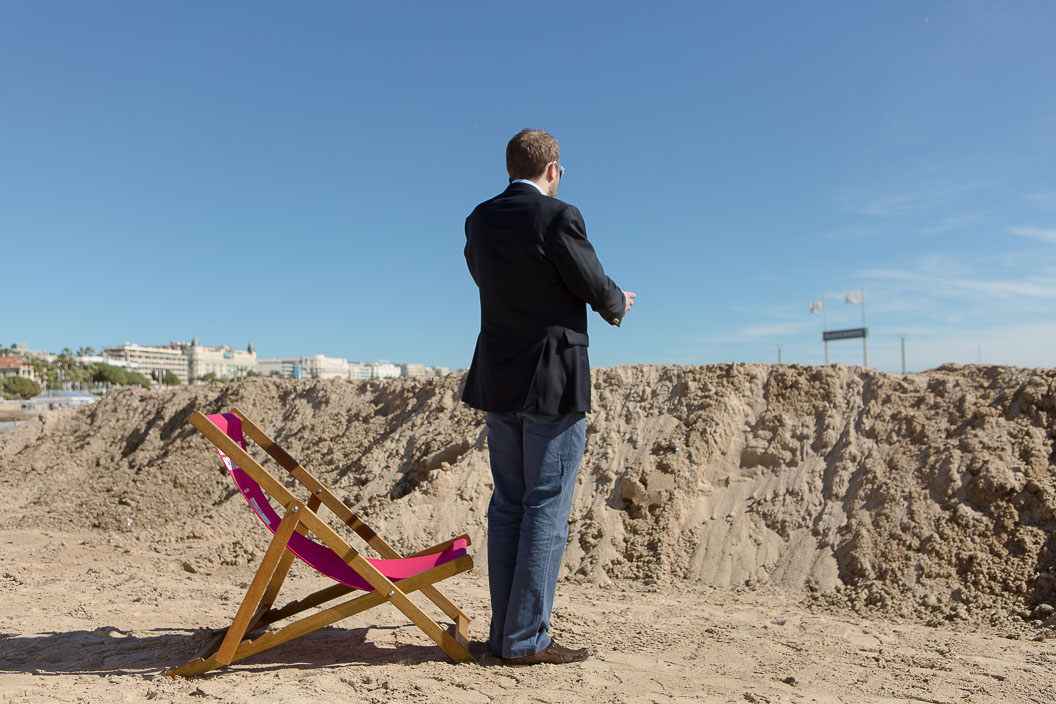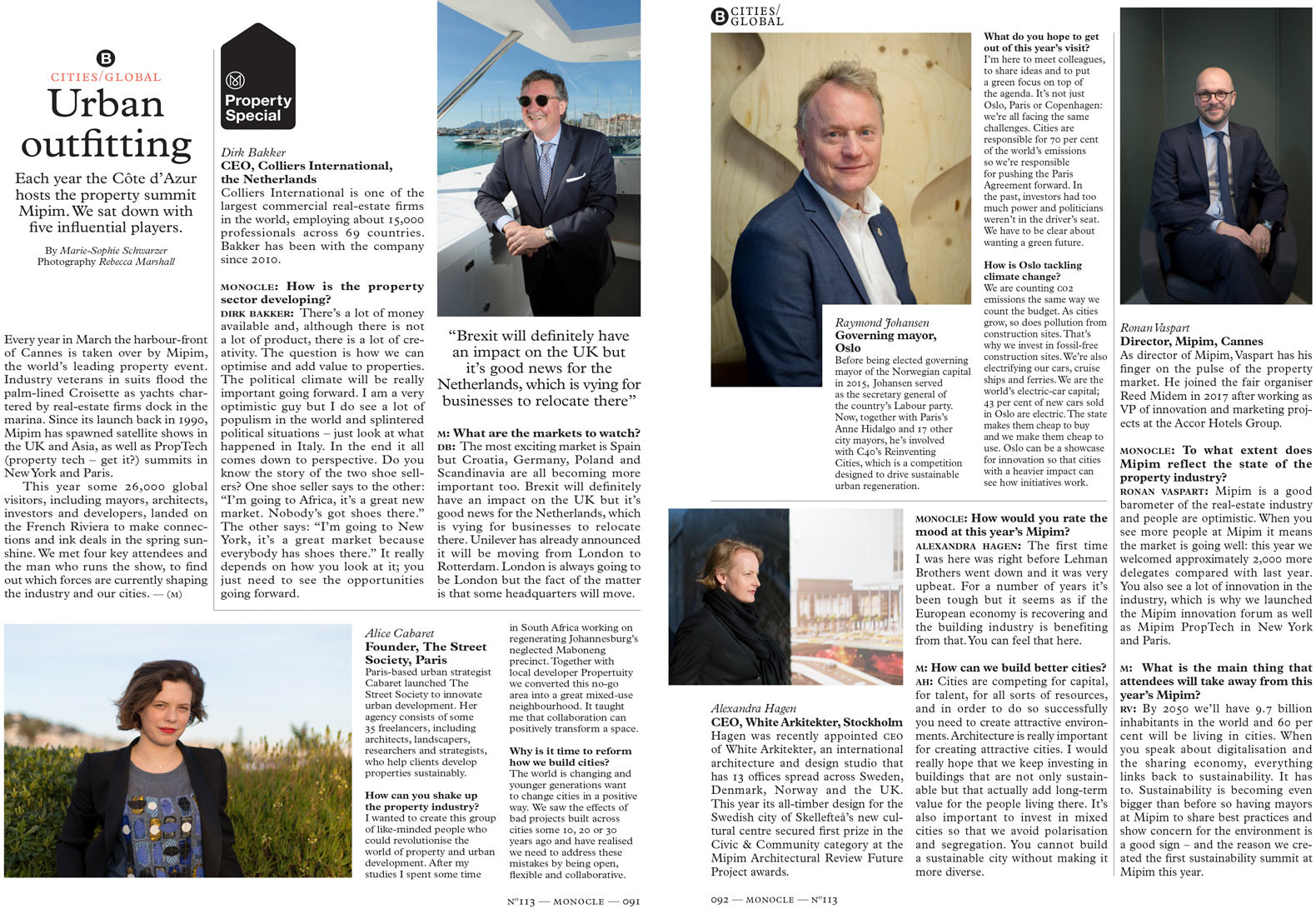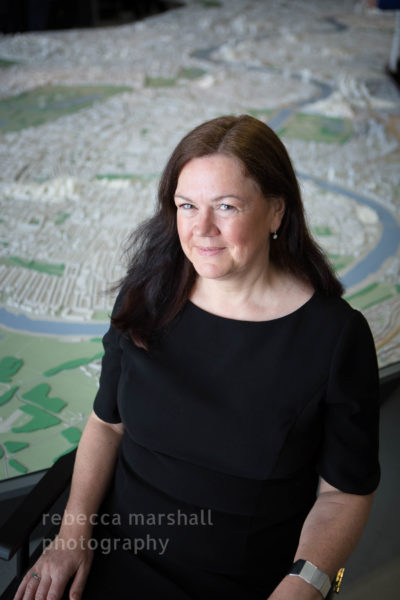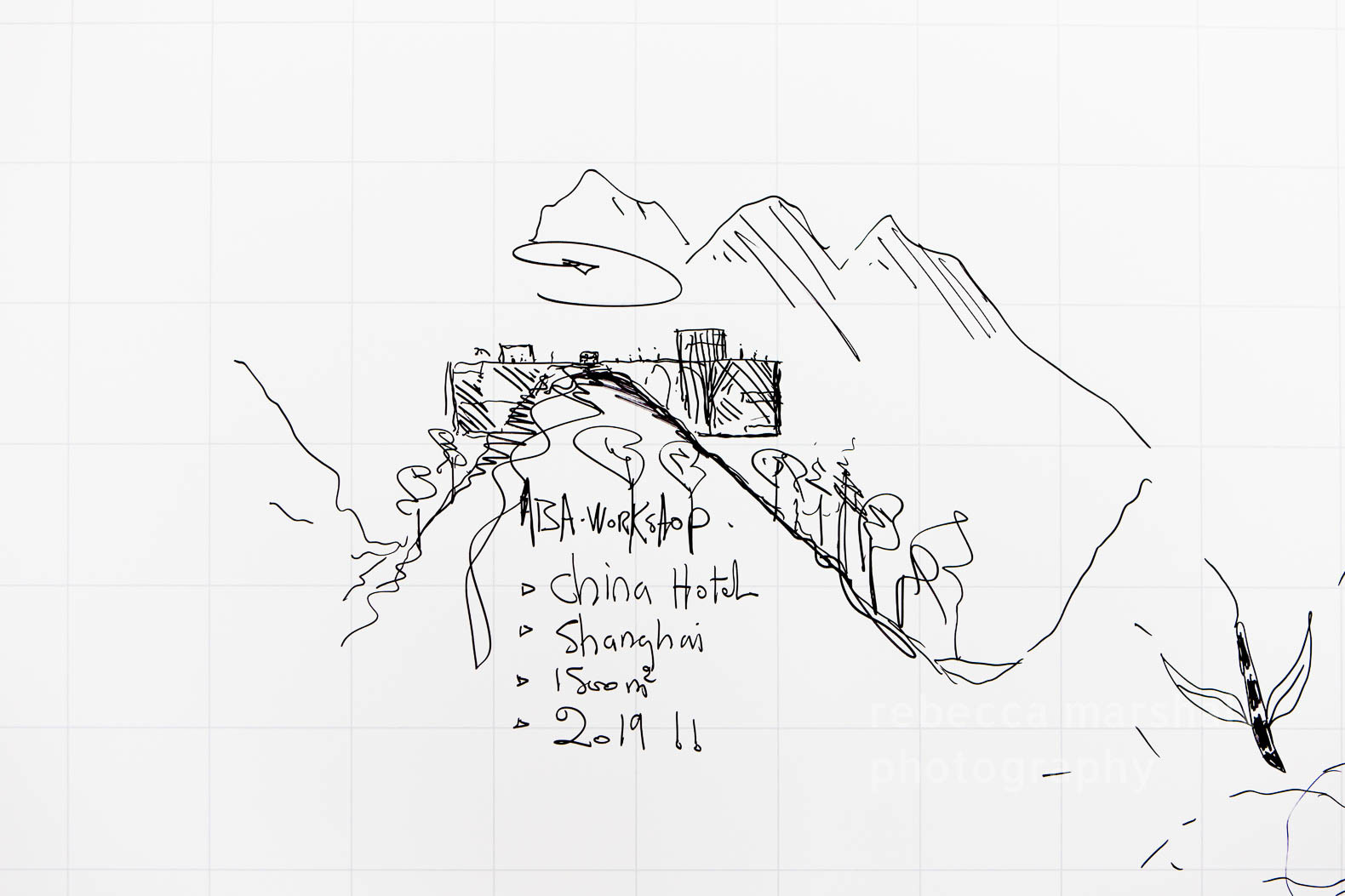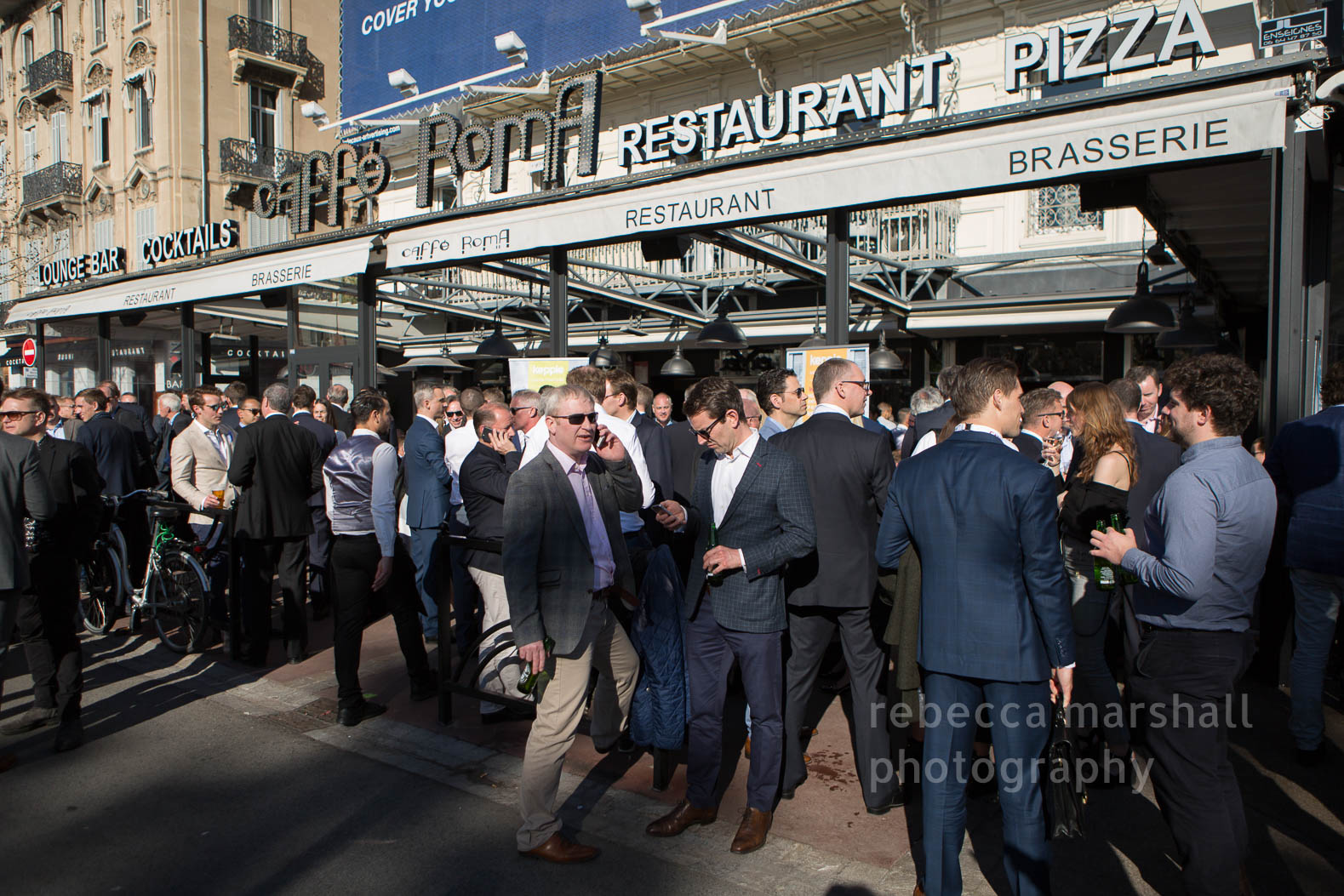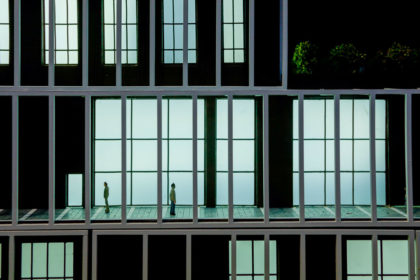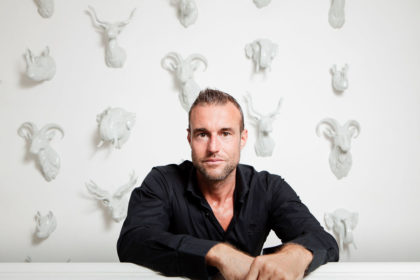A few weeks before hoards of movie buffs, journalists and photographers arrive in the South of France for its annual film festival, Cannes plays host to another huge crowd at the world’s leading property trade fair, Mipim. Monocle magazine commissions me regularly as photographer to make a reportage of this vast urban development event, but this year, the editorial direction had changed. The feature would take a portrait approach, telling the story of the event’s highlights through the eyes of prominent politicians, architects and property developers. Monocle flew journalist Marie over to Nice and I set out to meet her in Cannes and take beautiful, strong portraits of the key subjects after each interview. Straightforward, right?
Now, as other editorial photographers will know, there can be a gap between a picture desk’s concept of a shoot (blue-sky-dreamed-up in an office in London) and the reality faced by a photographer in another country, climate and conditions (e.g. a trade fair in the South of France). This time, the gulf between the two realities was virtually insurmountable. Every element of the brief posed its own challenge.
‘Scope the fair in advance’
Photo desk, London: “Spend the first morning looking for cool portrait locations. The key will be to find interesting locations and backgrounds within the fair to photograph people against”
Photographer, Cannes: It is difficult to get to know the layout of a trade fair and scout out good backgrounds when you can’t get in. My queries to Monocle about accreditation arrangements (MIPIM requires press photographers to provide an official letter from their commissioning magazine) weren’t answered until 10pm the night before the assignment. “Just fill out the form online, its straightforward“. The page announced that the application process had closed 2 weeks before.
So I had no choice but to arrive at registration empty-handed the next morning, and was met with predictable French shrugs. At that time, it was only 7 am in London so while I emailed my client, I couldn’t expect a letter any time soon. It took a long wait, several discussions with various members of MIPIM’s administrative hierarchy and the majority of my daily dose of patience by the time I got my badge (the picture editor’s letter, once he’d got into work, arrived 15 minutes later). Marie, a writer I’d never met or worked with before, had already been inside for a while and had hit the ground running. She was not in the loop that the photographer would spend the morning scouting. No, I arrived just as she was winding up her first interview with someone who could barely spare 2 minutes for a photo before he gave a speech and left the fair.
‘Make time for each portrait’
Photo desk, London: “This approach to the story will rely on spending some time with each person”
Photographer, Cannes: The first portrait rather set the tone for the rest. MIPIM is an event unlike any other, and I am not just saying that because I live on the French Riviera. Marie, who covers several large trade events around the world, was astonished by MIPIM’s unique brand of chaos. Its 24,500 mostly male delegates all appeared to be in meetings, rushing to meetings or trying to do one of those things, all of the time. We were told that target interview subjects unfortunately had no time for us after all, or they just didn’t turn up, or they could speak to us but at 3 pm not at 2 pm, and only for 15 minutes (“just a mini interview + a very quick photo“). At least it can be said that the global real estate economy appears healthy. However, these aren’t ideal conditions for meaningful portraits. One brief appointment with the mayor of a major European city was right after his boozy lunch (meeting). He’d had no time or apparent inclination to change (or sober up), and his PR manager paused momentarily to offer me a glass of champagne and the gift of a branded phone charger if I would Photoshop out the spaghetti stains on his white shirt and reduce the redness in his cheeks afterwards.
‘Choose a series of interesting backgrounds’
Photo desk, London: “Look for interesting textured backgrounds and colours that would work together in a series”
Photographer, Cannes: Even if I’d been able to recce the fair (which I hadn’t), and the subjects had been prepared to walk to a nearby location (which they hadn’t), that doesn’t mean there were attractive backgrounds anyway – or space amid the press of crowds to work with them. As for ‘working together in a series’, the best I could aim for were the most neutral backgrounds possible. I tried also to find visual hints of natural materials or the outdoors, as environmental sustainability of developments seemed to be a hot MIPIM topic.
However, again and again, practical problems got in the way. One portrait was that of Carolyn Dwyer, Director of the Built Environment for the City of London. Her PR team busily informed me both before and during the portrait that I had only 2 minutes, as she was already late for her next engagement. Crowds pressed around every available space in the London tent and the only option I came up with was to seat her next to a large model of London, in a little natural light from a door, and shoot her from above, to hide the background chaos. Marie valiantly tried to crowd control, but besuited men still pushed in between Carolyn and me, and my position, balancing on the top of a high stool I’d ‘borrowed’ from a stand, felt most precarious. Neither my safety nor the crispness of the photographs seemed assured by the footfalls of hundreds of people milling about the exhibition structure and making the floor vibrate.
‘Create interaction with stand elements’
Photo desk, London: The example layouts that I’d been sent with the brief were from another portrait-led trade fair feature, from a furniture design show in Copenhagen. Subjects had been photographed through a mirror, leaning on a designer chair, or gazing into a lovely lamp.
Photographer, Cannes: Property development is not furniture design, so it is perhaps unsurprising that beautiful details are largely absent at MIPIM. Stands are generally neither at the cutting edge of creative design, nor do they contain unnecessary aesthetic elements (to be fair, all the delegates are far too busy meeting each other to notice). Even the big city models of cities were looking tired (I recognised many from previous years). In digital times, screens or 3D wall projections are ‘de rigeur‘; wooden models are not. ‘Stand elements’ generally extended to a screen embedded in a bar top and glasses of bubbly sitting atop it.
‘If the fair isn’t working, try outdoors’
Photo desk, London: “If you can’t find what you need inside the fair, it might be good to try taking people outdoors”
Photographer, Cannes: Even the ‘if all else fails’ didn’t give me a decent back-up plan. The South of France sun was out in force, and it was bouncing merrily off all the white tents and glass of the exhibition stands. Even behind sunglasses, delegates were squinting, and bald heads were shining with perspiration.
It was only at the very end of our second, and last, day that a portrait finally went smoothly. The last interviewee was Alice Cabaret, the young Parisian founder of an innovative urban development agency, and both her project and her person stood out from the MIPIM mainstream. “Shall we go outside into the air for the interview? I can spare all the time you both need”
As it was, I didn’t need much. The sun was starting to set over the sea off Cannes, softening all the hard edges of the fair in a warm, langourous light. We talked a little, and now that busy men were all rushing away from le Palais des Festivals to their evening cocktail ‘meetings’ in town, I found a quiet spot for my portrait on the roof terrace. Alice was light, receptive and fun to work with and, as I took the very last frame in the sun’s dying rays, I thought that this wasn’t a bad way to end an almost-impossible assignment. In any case, as the French like to say, “Impossible n’est pas français” [‘Impossible doesn’t exist in French’].
